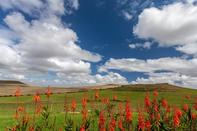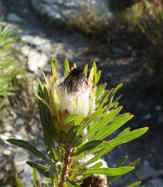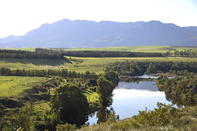The Cape's Floral Splendour
From the time I first became interested in natural history, I had heard of the wondrous splendours of the Cape fynbos, but even some years after moving to Cape Town from Johannesburg, I remained doubtful. I mean, the flowers were certainly pretty and varied, but where were these 18 great floral spectacles that the locals 'oohed' and 'aahed' about.

Then I walked the Swellendam trail one spring, and became a true fynbos nut. It was everything I had dreamed of and more: whole hillsides glazed with bright yellow leucadendron leaves; proteas of many colours and varieties bursting out on the hillsides; aloe succotrina (the Fynbos aloe), gladioli and watsonias, mimetes and Ericas painting the valleys in the brightest natural palette I had ever seen.
Some years later, I walked the same mountains in midsummer, and the orchids were on show. During this time I saw over 10 different species of ground orchid, among them some rare colour varieties and species.
I saw painted ladies, fire heaths, king proteas, rocket pincushions, moederkappies and blushing brides. In other words, all those flowering beauties that up till then had been to me mere mythical names of some far floral kingdom. With the exception of a few patches of Afro-montane forest and dune scrub.
Three Families of Fynbos

The three most characteristic families of the fynbos are the Erica heaths, the reed-like restio plants, and the many genera of the Proteaceae family. There are many more families represented in the fynbos biome - more than in any other veld type in the world, in fact, but these are the distinguishing ones.
The Afro-montane heathlands from which fynbos is derived originated in the tropics, and skipped down to the Cape along the mountain ranges of East Africa.
As the continent's climate has fluctuated over time, forests and heathlands have advanced and retreated up and down the mountain slopes. When the climate became wetter, the forests moved up from the lowlands and the heathlands were excluded from all but the highest mountain peaks and ridges.
During the periods when the climate was drier, the forests would be greatly diminished and the heathlands would advance down the mountain slopes, joining up with other expanding patches.
When this happened, the genetic composition of the veld type would be greatly invigorated, as the time between these genetic intercourses was sufficient for new species and hybrids to evolve in each separated patch. But today, the mountain environments all down east and southeast Africa are all much the same, and, truth be told, the montane heathlands did not change that much over all this time.
However, when they reached the Cape, they encountered contorted mountain ranges running east-west, with very dry interconnecting valleys, sandy and calcareous coastal plains, extreme weather conditions and quite different soils.
The vegetation took to this new territory like exuberant pioneers in a new and promised land, resulting in the huge quantity of extremely diverse species we have come to know as fynbos.
Natural Forests

The forest patches, like those found at Newlands on the Peninsula, on parts of the Swellendam Trail and in protected river valleys throughout the area, sad remnants of once widespread Afro-montane forests. Both climate and man have played their parts in decimating these primeval woodlands, through progressive drying, felling and burning.
These mature, moist forests, which make a canopy about 30 metres high, are also called podocarpus forests, after the yellowwoods (genus Podocarpus) that naturally dominate them. These are the same type of forests as those in Knysna, on the Drakensberg foothills and on the escarpment edge in Mpumalanga.
Apart from yellowwoods, the forests contain impressive tree species such as mountain hard pear, stinkwood, ironwood, Cape beech, Cape holly, rooiels, wild peach and assegai.
The riverine bush consists of wild almond trees (that may grow into old and very large, spreading trees), lance leaf trees (genus Metrosideros), some protea species like Leucadendrom salicifolium, the Restio Elegia capensis (Cape bamboo) and water witels. The list of plants and flowers is extensive.
By David Bristow The Fynbos Route is situated in the Overberg region of the Western Cape province of South Africa. This route takes you into the hidden corne...
The Fynbos Route is situated in the Overberg region of the Western Cape province of South Africa. This route takes you into the hidden corne... Flower season in the Cape is something magical to behold - Experience the beauty of spring wild flowers on The Cape Flower Season Route....
Flower season in the Cape is something magical to behold - Experience the beauty of spring wild flowers on The Cape Flower Season Route....